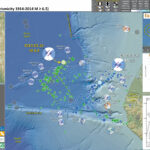While we were all excited about the local Gorda earthquake, there was an another interesting M 6.4 strike slip earthquake in the region of a recent series of earthquakes in the Scotia Sea. Sometimes earthquakes change the local stress field…
Aftershocks from the M 6.8 Gorda plate earthquake
Here are some maps i have put together that show the accumulated aftershocks from the M 6.8 Gorda plate earthquake on Sunday night. There was one M 3.3 earthquake less than 30 minutes before the main shock. I draw the…
radio interview on KMUD, local news Monday 3/10/14
Carrie from KMUD news interviewed me for the local news broadcast on Monday 3/10/14 and rebroadcast the following morning. KMUD archives their local news online for one year. Here is a recording of the KMUD local news. My interview is…
landslide between Redway and Garberville
Here are some photos from a landslide possibly triggered by the M 6.9 earthquake. It would be difficult to determine if this was caused by the rainfall or by the earthquake. Given that there were only a few landslides across…
aftershocks from the M 6.8 Gorda plate earthquake from 2014/03/10
Here are some updated maps for this morning. There have been quite a few aftershocks. There are reports of landslides along the bluffs between Redway and Garberville. Here is a map that just shows these 22 earthquakes: Here is a…
M 6.8 Gorda plate earthquake 2014/03/10
Updated map below. See additional more updated information about Gorda plate earthquakes in the Earthquake Report for the 10 January 2010 M 6.5 earthquake here. That was exciting. I counted over 40 seconds of motion in Manila. This is a…
